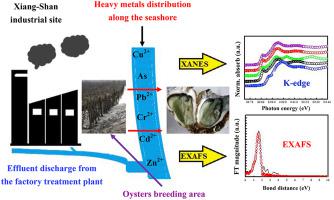Chemosphere ( IF 8.8 ) Pub Date : 2020-11-21 , DOI: 10.1016/j.chemosphere.2020.129067 Sikhumbuzo Charles Kunene , Kuen-Song Lin , Ndumiso Vukile Mdlovu , Wei-Cheng Shih

|
Copper (Cu) and zinc (Zn) concentrations in oyster soft tissues can be particularly high due to contamination, leading to extremely green/blue colors. This raises key questions regarding the behavior and speciation of trace metals in oyster soft tissues. This study investigated trace metal concentration profiles of contaminated Pacific oyster (Crassostrea gigas) soft tissues collected from trace metal-contaminated coastal area of Xiangshan District using inductively coupled plasma optical emission spectrometry (ICP-OES), energy dispersive X-ray (EDX), Fourier-transform infrared spectroscopy (FTIR), and X-ray photoelectron spectroscopy (XPS). Moreover, Cu and Zn speciation in contaminated and non-contaminated oyster soft tissues were investigated by X-ray absorption near edge structure spectroscopy/extended X-ray absorption fine structure (XANES/EXAFS) spectroscopic methods. The contents of Cu (1,100–1,400 mg/kg) and Zn (500–700 mg/kg) dry weight were high in oyster soft tissue samples. The XANES/EXAFS results revealed that Cu and Zn existed primarily as copper(II) oxide (CuO) and zinc oxide (ZnO) in contaminated oysters. Furthermore, Cu and Zn formed clusters with Cu–O and Zn–O interatomic distances of 1.97 and 2.21 Å, (coordination numbers 1.0 and 5.6), respectively. In non-contaminated oysters, the less abundant Cu and Zn existed mainly as copper(I) sulfide (Cu2S) and zinc sulfide (ZnS) forming clusters with Cu–S and Zn–S (thiolates) bond distances of 2.09 and 1.23 Å (coordination numbers of 4.6 and 2.4). These results provide further understanding on the chemical speciation of Cu and Zn in contaminated and non-contaminated oyster soft tissues as well as the bioaccumulation of trace metals in the oyster soft tissues.
中文翻译:

XANES / EXAFS光谱法测定太平洋牡蛎(Crassostrea gigas)中痕量金属的生物富集以及铜和锌的形态
由于污染,牡蛎软组织中的铜(Cu)和锌(Zn)浓度可能特别高,从而导致极绿色/蓝色。这就提出了关于牡蛎软组织中痕量金属的行为和形态的关键问题。这项研究调查了被污染的太平洋牡蛎(Crassostrea gigas)中的痕量金属浓度分布)使用电感耦合等离子体发射光谱(ICP-OES),能量色散X射线(EDX),傅里叶变换红外光谱(FTIR)和X射线光电子从痕量金属污染的沿海山区采集的软组织光谱(XPS)。此外,通过X射线吸收近边缘结构光谱法/扩展X射线吸收精细结构(XANES / EXAFS)光谱法研究了受污染和未受污染的牡蛎软组织中的铜和锌形态。在牡蛎软组织样品中,干重的铜(1,100–1,400 mg / kg)和锌的含量(500–700 mg / kg)较高。XANES / EXAFS结果表明,在受污染的牡蛎中,Cu和Zn主要以氧化铜(II)和氧化锌(ZnO)的形式存在。此外,Cu和Zn形成的簇的Cu-O和Zn-O原子间距离分别为1.97和2.21Å(配位数1.0和5.6)。在未污染的牡蛎中,含量较低的铜和锌主要以硫化铜(I)(Cu2 S)和硫化锌(ZnS)形成的簇,其中Cu–S和Zn–S(硫醇盐)的键距为2.09和1.23Å(配位数为4.6和2.4)。这些结果提供了对污染和未污染的牡蛎软组织中的铜和锌的化学形态以及牡蛎软组织中痕量金属的生物富集的进一步理解。



























 京公网安备 11010802027423号
京公网安备 11010802027423号